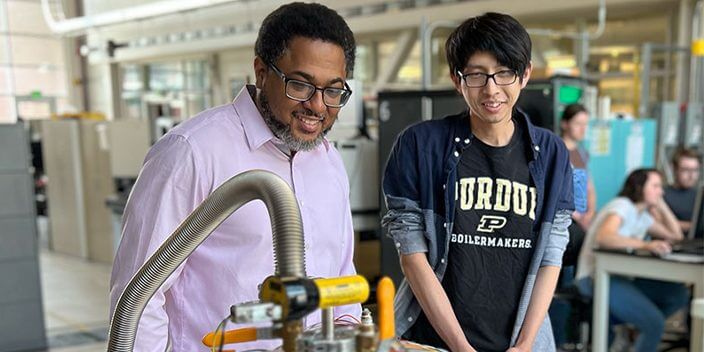Purdue researchers experiment with harvesting static electricity as an energy source

WEST LAFAYETTE, Ind. — Researchers in Purdue’s College of Engineering have developed an apparatus to generate and measure gas breakdown during contact electrification — the process responsible for static electricity. Their findings, published in Nature Communications, offer insight into the potential and limitations of this type of electricity when harvested as an energy source for a variety of devices, including e-textiles, wearables and smart packaging.
The apparatus, which is housed in an acrylic vacuum chamber, can isolate the potential materials used to make these devices and test their charge transfer capabilities without the use of an external voltage source. This creates the potential to improve the performance of these devices, as the apparatus measures the voltage generated between different pairs of materials.
The apparatus was designed and 3D printed by postdoctoral researcher Hongcheng Tao and associate professor of mechanical engineering James Gibert using additive manufacturing equipment at Ray W. Herrick Laboratories at Purdue University. Gibert has spent much of his career developing novel ways to generate electricity in unique situations. He has experimented with carboard boxes that power their own internal sensors, multifunction composite materials, and a tractor-trailer that harvests electricity from its own vibrations.
Tao and Gibert currently study the mechanisms behind triboelectric devices, which convert mechanical energy into electricity by rubbing two surfaces together. The surfaces can be either conductors or insulators, and they must be capable of reaching a high enough voltage to generate a sufficient electric charge without being damaged.
Triboelectric devices are still relatively in their infancy, with a number of researchers looking to further explore their potential. According to Gibert, there’s still a lot to learn about the physics behind triboelectrics.
“Typically, before you design one of these devices, you have to understand the application, including materials that are suitable for use and the power ranges required,” Gibert said. “So, our job is to investigate what can be achieved and what pairs of materials will give you the best voltage and subsequent current flow through a device.”
Quantifying that electric current between these materials can be difficult because, unlike similar apparatuses that use electrodes to demonstrate charge transfer, there is no external source generating a consistent, known voltage. So, Tao and Gibert had to find a workaround with their device that allowed them to calculate the voltage that is generated as the two materials make contact.
Their test apparatus consists of a small loading frame with motors that press and rub two sample materials together. The vacuum chamber removes all the air surrounding the device, and a single gas, such as nitrogen, is pumped into the chamber. As the samples make contact, they build up opposing charges. Then, when the samples are separated, the gas in the space between them breaks down and generates tiny sparks.
Tao and Gibert’s device measures that gas breakdown, or charge transfer, using a sensor that detects the Coulomb force — the attraction between the two charged objects. This measurement allows them to calculate the corresponding surface charge density that creates the attraction. From there, they can measure the charge transfer between the two samples.
The principle that governs this phenomenon, Paschen’s law, has been experimentally validated, but only between conductors. Tao and Gibert built their test apparatus to conduct the same experiment but with insulators.
“We have been assuming that Paschen’s law is valid when modeling gas breakdown in contact electrification, but there actually have not been sufficient experimental results to prove this,” Tao said. “So, we 3D printed every component to reconstruct an apparatus that was first implemented 30 years ago. All of the parts are flexible and customizable so we can ensure that all the samples align and the entire surface area is charged by contact.”
So far, Tao and Gibert have tested two combinations of materials: silicone-acrylic and copper-nylon, with the silicone-acrylic showing particular promise in generating a sufficient charge. When they perform these tests, they vary the pressure when the two samples make contact and the gap between them once they are separated. As a result of this process, they discovered some interesting phenomena.
“We found some regions where Paschen’s law didn’t hold,” Gibert said. “There are some regions where you have these discharges that can’t be explained by Paschen’s law. That’s an interesting finding that we’re hoping to look at in the future.”
So, while contributing to the development of triboelectric devices is the main objective for this research, Tao and Gibert are also excited about the basic science behind it all.
“The design of the device is largely an engineering challenge, but what’s really exciting is how the outcomes contribute to fundamental scientific knowledge. That’s the aspect we like most about this project,” Tao said. “I think it is very encouraging that a team of two people from an engineering department can still contribute to fundamental science research with a comparatively limited budget.”
This research was funded by an award from the National Science Foundation Division of Civil, Mechanical and Manufacturing Innovation (CMMI). CMMI funds innovative research that advances technologies related to manufacturing, materials and infrastructure.
About Purdue University
Purdue University is a public research institution demonstrating excellence at scale. Ranked among top 10 public universities and with two colleges in the top four in the United States, Purdue discovers and disseminates knowledge with a quality and at a scale second to none. More than 105,000 students study at Purdue across modalities and locations, including nearly 50,000 in person on the West Lafayette campus. Committed to affordability and accessibility, Purdue’s main campus has frozen tuition 13 years in a row. See how Purdue never stops in the persistent pursuit of the next giant leap — including its first comprehensive urban campus in Indianapolis, the new Mitchell E. Daniels, Jr. School of Business, and Purdue Computes — at https://www.purdue.edu/president/strategic-initiatives.
Writer/Media contact: Lindsey Macdonald, macdonl@purdue.edu
Sources: James Gibert, jgibert@purdue.edu
Hongcheng Tao, taoh@purdue.edu